The Contributions of Anders Celsius to Temperature Measurement
When we think about temperature measurement, the name Anders Celsius often comes to mind. His contributions to science have not only transformed how we measure temperature but have also laid the groundwork for modern thermometry. Born in 1701 in Uppsala, Sweden, Celsius was a mathematician and astronomer whose passion for understanding the natural world led him to develop a temperature scale that would bear his name. This article explores his groundbreaking work, the establishment of the Celsius scale, and its lasting impact on both scientific research and everyday life.
The Celsius scale, introduced in 1742, was revolutionary because it provided a clear and consistent method for measuring temperature based on the physical properties of water. This was a significant departure from previous temperature scales, which were often arbitrary and varied widely. Celsius defined his scale using two fixed points: the freezing point of water at 0 degrees Celsius and the boiling point at 100 degrees Celsius. This simple yet effective framework made it easier for scientists and laypeople alike to understand and communicate temperature measurements.
One of the most remarkable aspects of Celsius's work was the way he approached the concept of temperature. He didn’t just create a scale; he created a system that was intuitive and easy to use. Unlike the Fahrenheit scale, which is often seen as convoluted and less straightforward, Celsius's scale aligns perfectly with the natural world. For instance, it is readily apparent that when water freezes, it is at zero and when it boils, it is at one hundred. This clear relationship has made the Celsius scale the preferred choice in most of the world today.
In addition to its practicality, the Celsius scale has played a vital role in scientific research. By providing a standardized method of measurement, it has enabled scientists to conduct experiments and share their findings with accuracy and consistency. The universality of the Celsius scale has facilitated collaboration across borders and disciplines, allowing for significant advancements in fields such as chemistry, physics, and meteorology. Whether it's predicting weather patterns or conducting laboratory experiments, the Celsius scale remains a fundamental tool in the scientific toolkit.
Moreover, the adoption of the Celsius scale was not instantaneous. It took time for the scientific community and the public to embrace this new system. However, as more countries recognized the scale's efficiency and practicality, it gradually became the standard. Today, the Celsius scale is used in most parts of the world, with the notable exception of the United States, where Fahrenheit still reigns supreme in everyday contexts. Even so, in scientific settings, Celsius is often the go-to measurement for temperature.
In summary, Anders Celsius's contributions to temperature measurement have had a profound and lasting impact. His development of the Celsius scale has not only simplified the way we understand temperature but has also facilitated advancements in scientific research and everyday applications. As we continue to rely on his work in various fields, it is clear that Celsius's legacy will endure for generations to come.
- What is the Celsius scale? The Celsius scale is a temperature measurement system that defines the freezing point of water at 0 degrees and the boiling point at 100 degrees.
- Who was Anders Celsius? Anders Celsius was a Swedish mathematician and astronomer who created the Celsius temperature scale in the 18th century.
- Why is the Celsius scale important? The Celsius scale provides a standardized method for measuring temperature, making it easier for scientists and the general public to communicate and understand temperature readings.
- How does the Celsius scale compare to Fahrenheit and Kelvin? The Celsius scale is more intuitive than Fahrenheit, as its points are based on water's properties. Kelvin is an absolute temperature scale used primarily in scientific contexts.

The Life of Anders Celsius
Anders Celsius was born on November 27, 1701, in Uppsala, Sweden, into a family that valued education and science. His father, a professor of astronomy, undoubtedly influenced his early interest in the natural sciences. As a child, Celsius was curious, often exploring the world around him, which laid the foundation for his future endeavors in temperature measurement. He pursued his education at Uppsala University, where he was exposed to a wealth of knowledge that would shape his scientific career.
During his time at university, Celsius was not just a student; he was a passionate researcher. His academic journey led him to travel across Europe, where he studied under prominent scientists of his time. This exposure was critical, as it allowed him to absorb various scientific methodologies and philosophies. It was during these formative years that he began to contemplate the need for a standardized temperature measurement system, which was a significant challenge in the scientific community.
After completing his education, Celsius returned to Uppsala, where he took on the role of a professor. His position allowed him to conduct experiments and share his findings with students and fellow scientists. In 1730, he published his first major work, which focused on the properties of light and its relationship with temperature. However, his most significant contribution came a few years later, in 1742, when he introduced the Celsius temperature scale.
The Celsius scale, originally known as the centigrade scale, was revolutionary. Celsius defined the scale based on the freezing and boiling points of water, establishing a clear and practical framework for temperature measurement. This was not just a simple endeavor; it was a meticulous process that involved careful observation and experimentation. Celsius's work was groundbreaking, as it provided a consistent method for scientists to communicate temperature measurements, which was crucial for various fields, including meteorology, physics, and chemistry.
Despite his significant contributions to science, Anders Celsius's life was not without challenges. He faced skepticism from some of his contemporaries who were accustomed to the Fahrenheit scale. However, his dedication to scientific rigor and standardization eventually won over the scientific community. In fact, the Celsius scale gained widespread acceptance and became the standard in many countries, illustrating the importance of his work.
Sadly, Anders Celsius's life was cut short when he passed away on April 25, 1744, at the age of 42. Yet, his legacy endures. The Celsius scale remains one of the most widely used temperature scales in the world today. His contributions have not only influenced the field of metrology but have also paved the way for future advancements in science and technology.
In summary, Anders Celsius was a pioneering figure whose life was dedicated to the pursuit of knowledge. From his early education to his groundbreaking work in temperature measurement, Celsius's journey is a testament to the impact one individual can have on the scientific community. His legacy continues to inspire scientists and researchers around the world, proving that the pursuit of understanding is truly a timeless endeavor.

The Celsius Temperature Scale
The Celsius temperature scale, named after its creator Anders Celsius, is one of the most widely used temperature measurement systems in the world today. Established in 1742, this scale operates on a simple yet effective principle: it defines temperature based on the physical properties of water. At first glance, one might think that measuring temperature is straightforward, but Celsius's approach was revolutionary. He ingeniously set the freezing point of water at 0 degrees Celsius and the boiling point at 100 degrees Celsius under standard atmospheric conditions. This 100-degree interval makes it incredibly intuitive, allowing for easy mental calculations and comparisons.
One of the standout features of the Celsius scale is its linearity, which makes it a favorite among scientists and everyday users alike. Unlike some other temperature scales, Celsius provides a direct and proportional relationship between temperature changes and the numerical values assigned to them. For instance, a difference of 10 degrees Celsius represents the same change in thermal energy, whether you're moving from 20 to 30 degrees or from 80 to 90 degrees. This simplicity is part of what makes the Celsius scale so appealing and practical for various applications.
Moreover, the Celsius scale is often used in conjunction with the metric system, which enhances its utility in scientific research and global communication. In a world where precision and standardization are paramount, the Celsius scale provides a common language for discussing temperature, making it easier for scientists and researchers from different countries to collaborate effectively. This universality is one of the reasons why the Celsius scale has become a cornerstone of scientific measurement.
To truly appreciate the Celsius temperature scale, it’s essential to understand its historical background. Anders Celsius was a Swedish astronomer and physicist who lived during a time when temperature measurement was still in its infancy. Before Celsius, various temperature scales existed, but they were often inconsistent and based on subjective observations. Celsius sought to create a more reliable and systematic approach to temperature measurement.
In defining the zero point and boiling point of water, Celsius tapped into a universally accessible reference. Water is a substance that everyone is familiar with, and using it as a baseline for temperature measurement made practical sense. By establishing the freezing and boiling points of water as the two critical benchmarks of his scale, Celsius not only simplified temperature measurement but also made it relatable to everyday experiences. Imagine trying to explain temperature to someone without a common reference point—Celsius made sure that wouldn’t be a problem.
The introduction of the Celsius scale had far-reaching effects on scientific research. Prior to its widespread adoption, scientists often struggled with varying temperature scales, leading to confusion and errors in experiments. The Celsius scale facilitated a new era of standardized temperature measurement, allowing researchers to conduct experiments with confidence that their results could be replicated and understood by others. This standardization was crucial in fields such as chemistry, physics, and meteorology, where precise temperature control is essential for accurate results.
In conclusion, the Celsius temperature scale is not just a simple tool for measuring heat; it represents a significant leap forward in the way we understand and communicate about temperature. Its establishment has paved the way for countless advancements in science and technology, making it a vital component of our modern world.

The Origin of the Celsius Scale
When we think about temperature measurement, it's hard to imagine a world without the Celsius scale. But where did this revolutionary idea come from? The origin of the Celsius scale is deeply rooted in the scientific explorations of the 18th century, a time when many were eager to understand the natural world through observation and experimentation. Anders Celsius, a Swedish astronomer, was at the forefront of this movement, and his quest for a reliable method of measuring temperature led to the creation of a scale that would change the way we perceive heat and cold.
Celsius's journey began with his education in Uppsala University, where he was exposed to the wonders of physics and astronomy. He was influenced by the works of his predecessors, particularly the need for a standardized temperature measurement system. At that time, various temperature scales existed, but they were often inconsistent and confusing. Celsius aimed to solve this problem by developing a scale that was both practical and scientifically sound.
In 1742, Celsius introduced his temperature scale, which was initially based on two key reference points: the freezing point of water and the boiling point of water. He cleverly chose these points because they are easily reproducible and universally understood. This method of defining temperature was a significant departure from earlier scales, which often relied on arbitrary measurements. Celsius assigned 0 degrees to the freezing point of water and 100 degrees to the boiling point, creating a simple and intuitive framework.
But why did Celsius choose these specific points? The answer lies in the scientific principles of the time. The use of water as a reference was practical; water is abundant and essential to life, making it a relatable standard for everyone. By establishing these points, Celsius provided a clear and consistent way to measure temperature, which was crucial for scientific experimentation. His scale made it easier for scientists to communicate their findings and collaborate on research without the confusion of different measurement systems.
Moreover, the Celsius scale was not just a product of individual genius; it was also a reflection of the collaborative spirit of the scientific community. Celsius's work was built upon the findings of other scientists, and his scale quickly gained traction among his peers. As researchers began to adopt the Celsius scale, it became a cornerstone of scientific research and experimentation. The clarity and simplicity of the scale made it an ideal choice for laboratories, universities, and industries alike.
In summary, the origin of the Celsius scale is a fascinating story of innovation driven by the desire for clarity and consistency in temperature measurement. Anders Celsius's visionary approach not only laid the groundwork for modern thermometry but also fostered a spirit of collaboration among scientists. Today, we continue to benefit from his contributions, as the Celsius scale remains a vital tool in science, industry, and everyday life.

The Zero Point and Boiling Point
When we think about temperature, two critical reference points come to mind: the freezing point and the boiling point of water. Anders Celsius ingeniously defined these points to create a practical framework for measuring temperature. By establishing the freezing point of water at 0 degrees Celsius and the boiling point at 100 degrees Celsius, he provided a scale that was not only logical but also universally applicable. Imagine trying to bake a cake without knowing the right temperature to set the oven; Celsius’s scale offers a straightforward way to communicate thermal conditions, making it a vital tool for both scientists and everyday cooks alike.
The brilliance of Celsius's system lies in its simplicity and ease of use. By choosing water as the basis for his scale, he tapped into a substance that is ubiquitous in our daily lives. This decision was not arbitrary; water is essential to life, and its phase changes are critical in numerous scientific and practical applications. For example, when we boil water for tea, we intuitively understand that reaching 100 degrees Celsius is the point at which our water transforms into steam. This clarity helps everyone, from students in a classroom to professionals in a laboratory, grasp the concept of temperature without getting bogged down by complicated mathematics.
To further illustrate the significance of these reference points, consider the following table that outlines the Celsius scale in relation to other temperature scales:
| Temperature Scale | Freezing Point of Water | Boiling Point of Water |
|---|---|---|
| Celsius (°C) | 0 | 100 |
| Fahrenheit (°F) | 32 | 212 |
| Kelvin (K) | 273.15 | 373.15 |
This table not only highlights the differences between the Celsius scale and its counterparts but also emphasizes the intuitive nature of Celsius’s definitions. The zero point and boiling point are not just arbitrary numbers; they are anchored in the physical properties of water, making them relatable and easy to remember. As you can see, while other scales like Fahrenheit and Kelvin exist, Celsius’s straightforward approach allows for easier calculations and a more accessible understanding of temperature.
In conclusion, by defining the zero point and boiling point based on water, Anders Celsius created a temperature scale that resonates with our everyday experiences. This not only revolutionized scientific measurement but also made temperature a concept that everyone could grasp and utilize effectively. The legacy of his work continues to influence various fields, from meteorology to cooking, proving that sometimes, simplicity is the ultimate sophistication.

The Impact on Scientific Research
The introduction of the Celsius scale was nothing short of revolutionary, acting as a catalyst for significant advancements in scientific research. Before Celsius, temperature measurement was often inconsistent and varied widely across different regions and scientific disciplines. With the establishment of a standardized scale, researchers could communicate their findings with greater accuracy and reliability. Imagine trying to bake a cake without a reliable oven temperature; it would be a recipe for disaster! Similarly, scientific experiments require precise temperature control to yield valid results.
One of the most profound impacts of the Celsius scale was its role in the field of thermodynamics, a branch of physics that deals with heat and temperature and their relation to energy and work. The Celsius scale provided a uniform framework for scientists studying the behavior of gases, liquids, and solids under varying temperatures. This uniformity allowed for the formulation of laws and principles that govern energy transfer, which are fundamental to both physics and chemistry. For instance, the establishment of the ideal gas law, which describes the behavior of gases, is rooted in the accurate measurement of temperature.
Furthermore, the Celsius scale has been instrumental in fields such as meteorology, where temperature plays a crucial role in weather forecasting and climate studies. Meteorologists utilize the Celsius scale to report temperatures in a manner that is easily understood by the general public. This accessibility has fostered a greater awareness of climate change and its impacts, as temperature data is crucial for understanding global warming trends. Without a standardized scale like Celsius, public discourse on such vital issues would be muddled and confusing.
Moreover, the Celsius scale's adoption in laboratory settings has enhanced the reproducibility of scientific experiments. When researchers document their findings, they can refer to temperature measurements in Celsius, ensuring that others can replicate their work under the same conditions. This reproducibility is a cornerstone of the scientific method, allowing for validation and verification of results across various studies.
To highlight the significance of the Celsius scale in different scientific domains, consider the following table:
| Scientific Field | Application of Celsius Scale |
|---|---|
| Thermodynamics | Understanding energy transfer and behavior of gases |
| Meteorology | Weather forecasting and climate studies |
| Chemistry | Reactions that depend on temperature |
| Medicine | Body temperature measurement and health monitoring |
In conclusion, the impact of Anders Celsius's temperature scale on scientific research cannot be overstated. It has not only standardized temperature measurement but also facilitated advancements across various scientific fields. By providing a common language for temperature, the Celsius scale has bridged gaps between disciplines, enabling scientists to work collaboratively towards a deeper understanding of the natural world.
- What is the Celsius scale? The Celsius scale is a temperature measurement system that defines the freezing point of water at 0 degrees and the boiling point at 100 degrees under standard atmospheric conditions.
- How did Anders Celsius create his temperature scale? Anders Celsius developed his scale based on the properties of water, defining specific points that are easily reproducible and relevant to everyday life.
- Why is the Celsius scale preferred in scientific research? The Celsius scale is preferred because it provides a standardized and universally accepted method for measuring temperature, facilitating communication and reproducibility in experiments.
- How does the Celsius scale compare to Fahrenheit and Kelvin? The Celsius scale is more straightforward for everyday use, while Kelvin is primarily used in scientific contexts, especially in physics, due to its absolute zero point.

The Adoption of the Celsius Scale
When we think about temperature measurement, the Celsius scale is often the first one that comes to mind. But how did this scale, created by Anders Celsius, become the standard in so many countries? The adoption of the Celsius scale was not an overnight phenomenon; it was a gradual process influenced by various scientific, cultural, and political factors. Initially, Celsius's scale was met with skepticism, especially in regions where the Fahrenheit scale was deeply entrenched in everyday life. However, as the scientific community began to recognize the advantages of Celsius, particularly its simplicity and alignment with the metric system, its acceptance started to gain momentum.
One of the key turning points in the adoption of the Celsius scale was the rise of the metric system in the 19th century. As countries around the world began to embrace standardized measurements, Celsius's scale, with its clear and logical structure, fit perfectly into this new paradigm. The scale's zero point, which represents the freezing point of water, and its boiling point at 100 degrees, made it intuitive and easy to use, especially in scientific research. This practicality was a significant factor in its acceptance among scientists, who needed a reliable and consistent method for measuring temperature across various experiments and disciplines.
Moreover, the efforts of influential scientists and educators played a crucial role in promoting the Celsius scale. As more research was published using Celsius, it became increasingly difficult for skeptics to ignore its benefits. Universities began to teach the Celsius scale, while scientific journals started to publish findings exclusively using this measurement. The snowball effect of education and research solidified Celsius's place in the scientific community.
Globally, the adoption of the Celsius scale varied significantly. Countries in Europe were among the first to switch, largely due to the influence of the French Revolution and the subsequent push for metrication. By the 20th century, many nations had officially adopted Celsius as their primary temperature scale. Today, it is the standard in most parts of the world, with the notable exceptions of the United States and a few other countries that still primarily use the Fahrenheit scale.
To illustrate the adoption timeline, consider the following table that highlights key milestones in the Celsius scale's acceptance:
| Year | Milestone | Location |
|---|---|---|
| 1742 | Introduction of the Celsius scale by Anders Celsius | Sweden |
| 1790s | Metric system introduced in France | France |
| 1867 | International adoption of metric system | Various countries |
| 20th Century | Widespread adoption in Europe and beyond | Global |
In conclusion, the adoption of the Celsius scale was a multifaceted process driven by the need for standardization in scientific research, educational initiatives, and global movements toward metrication. As we measure temperature today, it's essential to recognize the historical journey that brought us to this point. Celsius's contribution to temperature measurement not only made our lives easier but also paved the way for a more unified approach to science and education across the globe.

Celsius vs. Other Temperature Scales
When it comes to measuring temperature, the Celsius scale is just one of several systems we use. Each scale has its unique characteristics and applications, making them suitable for different contexts. Understanding how Celsius compares to other temperature scales, such as Fahrenheit and Kelvin, can provide valuable insights into their practical uses in everyday life and scientific research.
The Celsius scale, which is based on the freezing and boiling points of water, is widely used around the world, especially in scientific contexts. But how does it stack up against Fahrenheit, which is predominantly used in the United States? To put it simply, while Celsius measures temperature based on the metric system, Fahrenheit is more aligned with the imperial system. This difference can lead to some confusion, especially for those who frequently travel between countries using different scales.
In practical terms, the freezing point of water is 0 degrees Celsius and 32 degrees Fahrenheit, while the boiling point is 100 degrees Celsius and 212 degrees Fahrenheit. This means that a temperature conversion between the two scales can often feel like a riddle. For instance, if someone tells you it’s 50 degrees Fahrenheit outside, you might wonder, "Is that warm or cold?" In contrast, if they say it’s 10 degrees Celsius, you can immediately picture a chilly day. This illustrates how Celsius provides a more intuitive understanding of temperature for most people around the globe.
Now, let’s talk about the Kelvin scale, which is primarily used in scientific research. Unlike Celsius and Fahrenheit, Kelvin is an absolute temperature scale, starting at absolute zero—the point where molecular motion stops. In the Kelvin scale, 0 K is equivalent to -273.15 °C. This makes Kelvin particularly useful in physics and chemistry, where understanding temperature at a molecular level is crucial. For example, when scientists conduct experiments in cryogenics or thermodynamics, they often use Kelvin to avoid negative numbers, which simplifies calculations.
Here’s a quick comparison of these three temperature scales:
| Scale | Freezing Point of Water | Boiling Point of Water |
|---|---|---|
| Celsius | 0 °C | 100 °C |
| Fahrenheit | 32 °F | 212 °F |
| Kelvin | 273.15 K | 373.15 K |
In summary, while the Celsius scale is user-friendly and widely accepted for everyday temperature measurements, Fahrenheit and Kelvin serve their purposes in specific contexts. Each scale has its strengths, and understanding these differences can enhance our grasp of temperature in various fields, from cooking to scientific research. So the next time you check the weather or conduct an experiment, you’ll have a clearer picture of how these scales relate to one another.
- What is the main difference between Celsius and Fahrenheit?
The main difference lies in their freezing and boiling points of water. Celsius uses 0 °C and 100 °C, while Fahrenheit uses 32 °F and 212 °F. - Why is Kelvin used in science?
Kelvin is used because it starts at absolute zero, making it ideal for scientific calculations involving thermal energy. - How do I convert Celsius to Fahrenheit?
To convert Celsius to Fahrenheit, you can use the formula: °F (°C × 9/5) + 32.

Fahrenheit and Kelvin Comparisons
When it comes to measuring temperature, the Celsius scale isn’t the only game in town. Two other prominent scales are Fahrenheit and Kelvin, each with its own unique characteristics and applications. Understanding the differences between these scales is crucial, especially in scientific and everyday contexts. So, let’s dive into the fascinating world of temperature scales!
The Fahrenheit scale, developed by Daniel Gabriel Fahrenheit in the early 18th century, is primarily used in the United States and a handful of other countries. It defines the freezing point of water at 32 degrees and the boiling point at 212 degrees. This scale can be quite confusing for those accustomed to the metric system, as it involves a rather convoluted range of numbers. For example, when the temperature is a sweltering 100°F, it feels like a heatwave, but in Celsius, that’s only about 37.8°C! The Fahrenheit scale is often criticized for its lack of scientific precision, but it remains popular in everyday use, especially in weather forecasts and cooking.
On the other hand, we have the Kelvin scale, which is the absolute temperature scale used primarily in scientific contexts. Named after the Scottish physicist William Thomson, 1st Baron Kelvin, this scale starts at absolute zero, the theoretical point where all molecular motion ceases, which is 0 K. To put it in perspective, absolute zero is equivalent to -273.15°C! The Kelvin scale is particularly important in fields like physics and engineering, where precise temperature measurements are crucial. Unlike Celsius and Fahrenheit, Kelvin does not use the degree symbol; instead, temperatures are simply expressed in Kelvin (e.g., 300 K).
| Feature | Celsius (°C) | Fahrenheit (°F) | Kelvin (K) |
|---|---|---|---|
| Freezing Point of Water | 0°C | 32°F | 273.15 K |
| Boiling Point of Water | 100°C | 212°F | 373.15 K |
| Absolute Zero | -273.15°C | -459.67°F | 0 K |
While the Celsius scale is widely accepted in most of the world for everyday temperature measurement, the Fahrenheit scale still holds its ground in the U.S. for daily use. Meanwhile, the Kelvin scale reigns supreme in scientific research, providing a universal standard that transcends cultural and geographical boundaries. Each scale has its advantages and applications, making them valuable tools in their respective domains. So, whether you're baking cookies, conducting experiments, or simply checking the weather, understanding these different temperature scales can help you navigate your temperature-related tasks with ease.
- What is the main difference between Celsius and Fahrenheit?
The main difference lies in their freezing and boiling points of water; Celsius uses 0°C and 100°C, while Fahrenheit uses 32°F and 212°F.
- Why is Kelvin used in scientific contexts?
Kelvin is used because it starts at absolute zero, allowing for a more precise measurement of thermal energy in scientific experiments.
- Can I convert between Celsius, Fahrenheit, and Kelvin easily?
Yes! There are simple formulas for conversion between these scales, and many online calculators can help with quick conversions.

Modern Applications of the Celsius Scale
The Celsius scale is not just a relic of scientific history; it is a vital tool in the modern world, permeating various aspects of our daily lives and industries. From the moment you check the weather on your smartphone to the precise temperature control in industrial processes, Celsius is everywhere. Its simplicity and practicality make it the preferred scale in most countries around the globe. But how exactly is it applied in contemporary settings? Let's dive in!
In the realm of meteorology, Celsius is the standard unit for reporting temperatures. When you hear the weather forecast, the temperatures you see are typically expressed in degrees Celsius. This is crucial for public safety and planning, as it helps people dress appropriately, prepare for extreme weather, and even manage energy consumption. For instance, a sudden drop in temperature can prompt warnings about frost, while a heatwave may lead to advisories about hydration and health precautions.
In the culinary world, Celsius plays a significant role as well. Recipes often specify cooking temperatures in degrees Celsius, making it easier for chefs around the world to create consistent and delicious dishes. For example, baking a cake at 180°C ensures that it cooks evenly, as opposed to using Fahrenheit, which can lead to confusion and inconsistencies. This universal understanding of temperature helps in maintaining quality and standards across different cultures and cuisines.
Moreover, in the medical field, Celsius is critical for monitoring body temperatures. Healthcare professionals use thermometers calibrated in Celsius to assess fever or hypothermia accurately. A normal human body temperature is around 37°C, and any significant deviation from this can indicate health issues requiring immediate attention. The clarity and straightforwardness of the Celsius scale help ensure that medical practitioners can communicate effectively about patient conditions.
In industrial applications, precise temperature control is essential for processes such as manufacturing and chemical reactions. Many industries utilize Celsius in their temperature monitoring systems, ensuring that products are created under optimal conditions. For instance, in the production of pharmaceuticals, maintaining a specific temperature range during drug synthesis is crucial for efficacy and safety. Thus, Celsius provides a standardized framework that enhances efficiency and safety across various sectors.
To give you a better idea of how widely the Celsius scale is adopted, here’s a quick overview of its applications:
| Field | Application |
|---|---|
| Meteorology | Weather forecasting and climate studies |
| Culinary | Cooking temperatures in recipes |
| Healthcare | Monitoring body temperature |
| Industry | Temperature control in manufacturing processes |
In summary, the Celsius scale is more than just a method of measuring temperature; it is a fundamental aspect of modern life that influences various sectors. Its widespread acceptance and practical applications make it an indispensable tool for scientists, chefs, healthcare providers, and industrialists alike. As we continue to innovate and advance in technology, the relevance of the Celsius scale will likely grow, proving that Anders Celsius's contributions remain vital even centuries later.
- Why is Celsius preferred over Fahrenheit in most countries? The Celsius scale is based on the freezing and boiling points of water, making it more intuitive for everyday use.
- How is Celsius used in scientific research? Celsius provides a standardized method for temperature measurement, essential for reproducibility in experiments.
- Are there any industries that still use Fahrenheit? Yes, primarily in the United States, Fahrenheit is still widely used in household and weather contexts.
- What is the relationship between Celsius and Kelvin? Kelvin is an absolute temperature scale where 0 K is absolute zero. To convert Celsius to Kelvin, simply add 273.15.

The Legacy of Anders Celsius
Anders Celsius may have lived in the 18th century, but his impact on the world of science and temperature measurement is as relevant today as it was back then. His invention of the Celsius scale revolutionized how we perceive and quantify temperature, creating a universal language for scientists and everyday people alike. Imagine a world where temperature could be measured without confusion—Celsius made this possible, and his legacy continues to resonate across various fields, from meteorology to medicine.
One of the most significant aspects of Celsius's legacy is the standardization of temperature measurement. Before his scale, different regions used various systems, leading to inconsistencies and confusion. Celsius's approach provided a simple yet effective framework, making it easier for scientists to communicate their findings. This standardization not only facilitated collaboration among scientists but also enhanced the accuracy of experiments, allowing for more reliable data collection and interpretation. Today, the Celsius scale is used globally, demonstrating the far-reaching influence of his work.
Moreover, the Celsius scale's design, which is based on the freezing and boiling points of water, reflects a deep understanding of the natural world. This practical approach to temperature measurement has made it the preferred scale in many scientific disciplines. As we delve into fields like chemistry, physics, and environmental science, the Celsius scale remains integral. For instance, in climate studies, accurate temperature readings are crucial for understanding global warming trends and making informed decisions about environmental policies.
In addition to its scientific applications, the Celsius scale has found its way into our daily lives. From weather reports to cooking recipes, we encounter temperature measurements in Celsius almost everywhere. This familiarity makes it easier for people to understand and engage with temperature-related information. In a world that's becoming increasingly interconnected, Celsius's legacy is a testament to the importance of clear communication in science and everyday life.
As we reflect on Anders Celsius's contributions, it's essential to recognize that his work laid the groundwork for future advancements in metrology. His influence can be seen in the development of modern temperature measurement tools and techniques, which continue to evolve with technology. For example, digital thermometers and advanced sensors often utilize the Celsius scale, ensuring that we maintain a consistent and accurate understanding of temperature across various applications.
In summary, Anders Celsius's legacy is not just about the scale he created; it's about the profound impact his work has had on science, industry, and society as a whole. His emphasis on standardization, practicality, and clarity in temperature measurement has paved the way for countless advancements and continues to shape our understanding of the world around us. As we move forward, we owe much to this remarkable figure who made temperature measurement accessible and meaningful for generations to come.
- What is the Celsius scale based on? The Celsius scale is based on the freezing point (0°C) and boiling point (100°C) of water at standard atmospheric pressure.
- Why is the Celsius scale important? The Celsius scale is important because it provides a standardized way to measure temperature, facilitating communication and collaboration in scientific research and everyday applications.
- How does Celsius compare to Fahrenheit? Celsius is a metric scale that is based on the properties of water, while Fahrenheit is based on a different set of reference points. This can lead to confusion when converting between the two scales.
- Is the Celsius scale used globally? Yes, the Celsius scale is widely used around the world, especially in scientific contexts, while Fahrenheit is primarily used in the United States.
Frequently Asked Questions
- What is the Celsius scale?
The Celsius scale is a temperature measurement system that defines 0 degrees as the freezing point of water and 100 degrees as the boiling point at standard atmospheric pressure. It was developed by Anders Celsius in the 18th century and is widely used around the world today.
- How did Anders Celsius come up with the Celsius scale?
Anders Celsius created his temperature scale based on the properties of water. He chose the freezing and boiling points of water to establish a simple and practical framework for temperature measurement, making it easier for scientists to communicate and record temperatures.
- Why is the Celsius scale preferred over Fahrenheit in many countries?
The Celsius scale is often preferred because it is based on the metric system, which is more universally accepted for scientific measurements. Additionally, the scale's relation to water, a common substance, makes it intuitive and easier to understand for everyday use.
- What are the differences between Celsius, Fahrenheit, and Kelvin?
Celsius is based on the freezing and boiling points of water, Fahrenheit is based on a different set of reference points, and Kelvin is the absolute temperature scale used in scientific contexts. Each scale has its own applications, but Celsius is often favored in scientific research due to its straightforward relationship with water.
- How has the Celsius scale impacted scientific research?
The Celsius scale has significantly standardized temperature measurement in scientific research, allowing for consistent data collection and comparison across different experiments and studies. This uniformity has facilitated advancements in various fields, including chemistry, physics, and meteorology.
- Is the Celsius scale used globally?
Yes, the Celsius scale is used in most countries around the world, especially for scientific and academic purposes. However, some countries, like the United States, still commonly use the Fahrenheit scale for everyday temperature measurements.
- What are some modern applications of the Celsius scale?
The Celsius scale is utilized in various contemporary applications, including weather forecasting, cooking, scientific research, and industrial processes. Its relevance in daily life is evident in everything from household thermometers to laboratory equipment.
- What legacy did Anders Celsius leave behind?
Anders Celsius's legacy is profound in the field of metrology. His contributions to temperature measurement have not only standardized scientific practices but also continue to influence how we understand and interact with temperature in our daily lives.



















